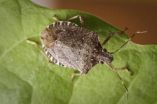(Press-News.org) Brown marmorated stink bugs cause millions of dollars in crop losses across the United States because of the damage their saliva does to plant tissues. Researchers at Penn State have developed methods to extract the insect saliva and identify the major protein components, which could lead to new pest control approaches.
"Until now, essentially nothing was known about the composition of stink bug saliva, which is surprising given the importance of these insects as pests and the fact that their saliva is the primary cause of feeding injury to plants and crop losses," said Gary Felton, professor and head of the Department of Entomology. "Other than using synthetic pesticides, there have been few alternative approaches to controlling these pests. By identifying the major protein components of saliva, it now may be possible to target the specific factors in saliva that are essential for their feeding and, therefore, design new approaches for controlling stink bugs."
The team reported its results in today's (Feb. 26) issue of PLOS ONE.
According to Felton, stink bugs produce two types of saliva that are required for successful feeding. Watery saliva helps stink bugs to digest their food. Sheath saliva surrounds stink bugs' mouthparts and hardens to prevent spillage of sap during feeding. The hardened "sheath" remains attached to the plant when the insect is finished feeding.
"Unlike a chewing insect, which causes damage by removing plant tissue, stink bugs pierce plant tissue and suck nutrients from the plant," said Michelle Peiffer, research support assistant. "During this process, stink bugs also deposit saliva onto the plant. The interaction between this saliva and the plant is what causes the cosmetic and physiological changes that make crops unmarketable."
To extract the two types of saliva from brown marmorated stink bugs, Felton and Peiffer first collected adult bugs from homes and fields in central Pennsylvania and maintained them in their laboratory.
The researchers chilled the insects on ice. As the insects returned to room temperature, their watery saliva was secreted from the tips of their beaks. The team collected this saliva, processed it and analyzed it for protein content.
To collect sheath saliva, the scientists placed organic grape tomatoes in the cages. After two days of stink bug feeding, they removed the tomatoes from the cages and used forceps to extract the hardened sheaths from the surfaces of the tomatoes. They then processed and analyzed the sheaths for protein content.
"We found that the watery saliva and the sheath saliva have distinct protein profiles," Felton said. "In other words, we did not find any proteins in common between the two."
Consistent with a role in digestion, the team found that watery saliva contains several digestive proteins, including amylases, proteases and an esterase.
In the sheath saliva, the researchers found peroxidase, suggesting that this protein could be involved in sheath formation. In addition, they found a large number of proteins from tomato.
"These results reveal that the protein composition of the sheath is a mixture of insect- and plant-derived proteins," Felton said. "We used extraordinary precaution to avoid disrupting tomato tissues during the collection of the sheaths, so we do not believe that the composition of tomato proteins in the sheath material is a spurious artifact of our collection methods, but rather it represents the natural coalescing of insect- and plant-derived proteins that occurs during formation of the sheath and subsequent feeding. These initial findings suggest that sheath saliva may elicit a plant self-protection response."
According to the scientists, the methods they developed to extract the saliva and to analyze the proteins should be generally applicable for any species of stink bug.
In the future, the team plans to use a genetic approach to test the function of individual proteins in the saliva to determine their function and essentiality to the feeding process.
"By understanding the specific details of feeding and the damage it causes, researchers can begin to develop targeted control methods for these pests," Peiffer said.
INFORMATION:
Support for this research was provided by the U.S. Department of Agriculture's National Institute of Food and Agriculture specifically, the Coordinated Agricultural Project of the Specialty Crop Research Initiative. The Coordinated Agricultural Project includes more than 50 researchers from 10 institutions and is led by Tracy Leskey of the U.S. Department of Agriculture's Agricultural Research Service.
Characterization of stink bug saliva proteins opens door to controlling pests
2014-02-26
ELSE PRESS RELEASES FROM THIS DATE:
New data book outlines Hispanic/Latino health
2014-02-26
The National Heart, Lung, and Blood Institute, part of the National Institutes of Health, released the largest and most comprehensive health and lifestyle analysis of people from a range of Hispanic/Latino origins. The data will enable individuals, communities, and policy makers to tailor better health intervention strategies.
"This study lays the foundation for future research on the possible causes of chronic diseases and ways to prevent them, and to help us understand the reasons why Hispanics and Latinos live longer than the general population," said Gregory Talavera, ...
Research maze puts images on floor, where rodents look
2014-02-26
PROVIDENCE, R.I. [Brown University] — A rodent in a maze is a staple — even a stereotype — of experimental psychology research. But the maze in the lab of Rebecca Burwell, professor of cognitive, linguistic, and psychological sciences at Brown University, is not your grandfather's apparatus. In a new video article published in the Journal of Visualized Experiments, Burwell's research group demonstrates in full detail how the maze can be used to perform automated visual cognitive research tasks with great efficiency.
The article is available here: http://www.jove.com/video/51316/automated-visual-cognitive-tasks-for-recording-neural-activity-using
The ...
Mayo Clinic discovers African-Americans respond better to rubella vaccine
2014-02-26
ROCHESTER, Minn. — Feb. 26, 2014 — Somali Americans develop twice the antibody response to rubella from the current vaccine compared to Caucasians in a new Mayo Clinic study on individualized aspects of immune response. A non-Somali, African-American cohort ranked next in immune response, still significantly higher than Caucasians, and Hispanic Americans in the study were least responsive to the vaccine. The findings appear in the journal Vaccine.
"This is fascinating," says Gregory Poland, M.D., Mayo Clinic vaccinologist and senior author of the study. "We don't know ...
JILA physicists discover 'quantum droplet' in semiconductor
2014-02-26
BOULDER, Colo -- JILA physicists used an ultrafast laser and help from German theorists to discover a new semiconductor quasiparticle—a handful of smaller particles that briefly condense into a liquid-like droplet.
Quasiparticles are composites of smaller particles that can be created inside solid materials and act together in a predictable way. A simple example is the exciton, a pairing, due to electrostatic forces, of an electron and a so-called "hole," a place in the material's energy structure where an electron could be, but isn't.
The new quasiparticle, described ...
Pine forest particles appear out of thin air, influence climate
2014-02-26
Pine forests are especially magical places for atmospheric chemists. Coniferous trees give off pine-scented vapors that form particles, very quickly and seemingly out of nowhere.
New research by German, Finnish and U.S. scientists elucidates the process by which gas wafting from coniferous trees creates particles that can reflect sunlight or promote cloud formation, both important climate feedbacks. The study is published Feb. 27 in Nature.
"In many forested regions, you can go and observe particles apparently form from thin air. They're not emitted from anything, ...
A predictive fitness model for influenza
2014-02-26
Researchers at Columbia University and the University of Cologne have created a new model to successfully predict the evolution of the influenza virus from one year to the next. This advance in our understanding of influenza suggests a new, systematic way to select influenza vaccine strains. The findings appear in Nature on Feb. 26.
The flu is one of the major infectious diseases in humans. Seasonal strains of the influenza A virus account for about half a million deaths per year. In a concerted effort, WHO and its Collaborating Centers have closely monitored the evolution ...
Sunburns strike twice
2014-02-26
Melanoma is particularly dangerous because it can form metastases in vital organs such as the lungs, liver or brain. UV radiation is considered to be the most significant triggering factor. An interdisciplinary team of researchers from the University Hospital and the LIMES Institute of the University of Bonn has now discovered that sunburns contribute to the development of this malignant disease not only through direct alteration of pigment cell genomes but also indirectly through inflammatory processes in the surrounding tissue. The results are now being published online ...
Major enigma solved in atmospheric chemistry
2014-02-26
According to their results, these extremely low-volatile organic compounds consist of relatively large molecules which contain an almost equal number of carbon, oxygen, and hydrogen atoms. The scientists present a plausible explanation supported by numerous experimental findings of how these vapours are formed almost immediately when plant emissions (e.g. monoterpenes) are released into the air. The vapours can then condense on small aerosol particles (starting from clusters of only a few nanometres in diameter) suspended in the air, causing them to grow to around 100 nanometres ...
Is therapeutic hypothermia beneficial in all patients following cardiac arrest?
2014-02-26
New Rochelle, NY, February 26, 2014–Whole body cooling in comatose patients who have suffered a heart attack can limit the damage to brain tissue caused by the restoration of blood flow and oxygen. But new data indicate that in certain patients therapeutic hypothermia is less effective and may even worsen neurological outcomes, as described in an article in Therapeutic Hypothermia and Temperature Management, a peer-reviewed journal from Mary Ann Liebert, Inc., publishers. The article is available free on the Therapeutic Hypothermia and Temperature Management website at ...
Researchers find virtual computer-based world an effective learning environment
2014-02-26
(Boston)--Boston University School of Medicine (BUSM) researchers have demonstrated the potential of using a virtual computer environment for distance healthcare education for an international audience that often has limited access to conventional teaching and training. In this pilot project led by John Wiecha, MD, corresponding author of the study and associate professor of family medicine at BUSM, a virtual world was created in which participants engaged in a learning activity by creating virtual avatars of themselves to navigate through a three-dimensional computer environment ...



